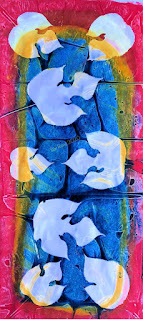There were a few gorgeous, warm days in the beginning of November that just called out for some printmaking to finish up the season. Luckily, I had plenty of dried and pressed leaves set aside for just such a moment, and I was able to make three large panels on cotton sateen.
I had chanced across some red mulberry leaves earlier in the fall, and was very excited about them. I've worked with the non-native white mulberry many times before, but these very large, native species leaves were new to me. For the first two prints, I used just the red mulberry leaves, and for the third I combined one with some sumac leaves and white mulberry twigs. Look at that size difference! When things like this excite you, you will never be bored,
I used a combination of cyanotype chemicals and Jacquard's Solarfast sun-activated dyes. They are not really meant to be used together, nor to be used in long exposures, but with experimentation I've worked out a process that gives me results I like. Here are the prints after exposure, but before rinsing them out.
This third image is a bit funky; the weather turned quickly at the end of the second day of printmaking and I brought this one in before a deluge of rain and took a quick picture of it inside.
Here are the finished prints. All three are about 2 ft. x 4 ft. I am delighted with them.
I have plans for them; they are joining a very long queue of projects.
This has obviously been a very weird and scary year to date, and I am somewhat disorganized and scattered, but at least I have some great prints to point to and think about.
A reminder that you can also follow on your platform of choice:
Facebook page:http://www.facebook.com/suerenostudio
Twitter feed: http://twitter.com/suereno
Tumblr: http://suerenostudio.tumblr.com
Instagram: https://www.instagram.com/sue_reno_studio/
Twitter feed: http://twitter.com/suereno
Tumblr: http://suerenostudio.tumblr.com
Instagram: https://www.instagram.com/sue_reno_studio/


















































